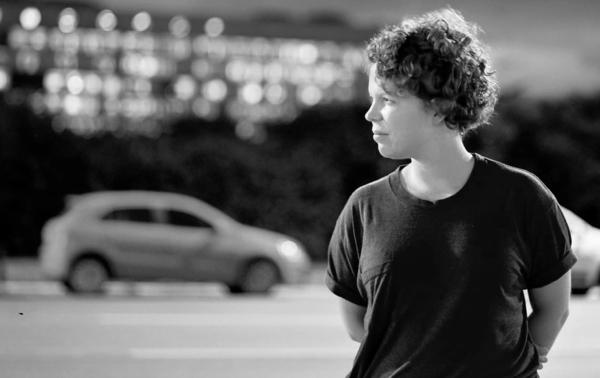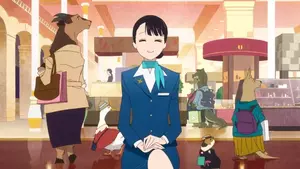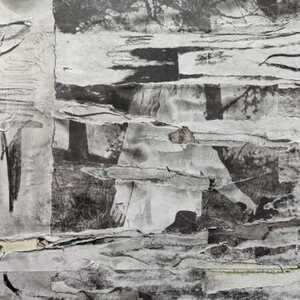
Joana Pimenta
by Generoso and Lily Fierro
Less than a week after voters selected Luiz Inácio Lula da Silva as the next President of Brazil, we had the opportunity to speak with Portuguese-born director Joana Pimenta on the occasion of the AFI Fest screening of Dry Ground Burning (Mato Seco em Chamas), her newest feature, which she co-directed with Adirley Queirós.
We first encountered Pimenta’s immense talents as a storyteller when she lensed Adirley Queirós’s low-budget dystopian science fiction film, Once There Was Brasilia (Era uma Vez Brasília), one of our top ten films of 2018. Set in the struggling district of Ceilândia, Once There Was Brasilia effectively repurposed cinematic tropes as a tool to expand on how the political landscape of its respective period impacted a community that had long suffered since the construction of the city of Brasilia. However, even though it is set in the same district and also incorporates and recontextualizes known film references, Dry Ground Burning diverges from Brasilia in how it integrates documentary to play against genre cinema images, amplifying the dour reality in Ceilândia and adding a fierce urgency to the film’s depiction of the current political situation in Brazil and the programmatic incarceration of its citizens.
Dry Ground Burning follows the exploits of Chitara (Joana Darc Furtado) and Léa (Léa Alves da Silva), life-hardened half-sisters who have tapped into an underground pipeline that provides them with the gasoline that they then sell to bikers in their favela of Sol Nascente, an area in dire need of any form of economic infrastructure. Concurrently, Chitara and Léa’s friend, Andreia (Andreia Vieira), who enters the film as a fellow gasolinheira, shifts into a political role by drawing together her community to support her campaign to become Sol Nascente’s district deputy candidate for the Prison People Party. Throughout Dry Ground Burning, Pimenta and Queirós provide their actors with ample space to engage each other in dialogues that build empathy for their situations, while the actions playing out around them provide us with a clear and biting metaphor of their government’s failed policies that led to the economic despair in their part of the country.
During our hour-long, in-depth conversation with Pimenta, we discussed her approach to Dry Ground Burning in her roles as both a cinematographer and as a co-director, the complex issues connected to the casting of Léa, the construction of the very real campaign of Andreia, the role of the Evangelicals in her film and in Brazil, and the election of Lula, which happened only days before our talk.
• •
LF: We were fortunate to see Once There Was Brasilia at Locarno in Los Angeles in 2018, and it was one of our favorite films of that year. Whereas Once There Was Brasilia leans heavily on action and visuals for its narrative, much of the weight of Dry Ground Burning is carried on the shoulders of the conversations and interactions of Léa and Chitara. How did this difference shape your approach as a cinematographer?
JP: We wanted to make a film about the daughters of the women who built the city of Ceilândia. If you’ve seen Brasilia and this film, you may know a bit of this story already, but in the 1960s, the President of Brazil at the time decided to build a new capital in the geographic center of the country, so he drew an “X” on the ground in a place that was only just desert before. To facilitate this project, they had to bring in construction workers in open trucks from all over Brazil. Once Brasilia was built, they created this thing called the Campaign for Eradication of Invasions, which is where the “CEI” that is inside the name Ceilândia comes from, and they proceeded to remove everyone who worked on the development to a city 50 km away from Brasilia, which became Ceilândia. After they removed these construction workers, they also removed the women who had been brought to the workers’ city to work as prostitutes because the laborers had not arrived with their families. Many of these women brought small children with them or were pregnant and became single mothers. As a result, because the men were working, they relied on these women to build the shacks and find water and electricity, so these women were the ones who actually built Ceilândia from the ground up. One of these women in Dry Ground Burning is Léa’s mother, and the other is Chitara’s mother, whom we filmed a lot, but unfortunately those scenes didn’t make it into the final cut. And, as discussed in the film, Léa and Chitara both shared the same father, so all four women’s stories are representative of the history of Ceilândia itself.
We knew that we wanted to work with these daughters of the women who had built Ceilândia, this second generation who are also single mothers and who also have an important leadership role in the life of the city. This is where all of the conversation in the film comes from in Dry Ground Burning. These women are not like this new group of women in the city who are in their 20s and are taking over the streets. They have a different kind of body, a different way of dressing, even a different kind of music — they listen to funk, whereas the generation of Léa and Chitara mostly listen to the kind of rap that you hear in the film, and in that way, we thought of Léa and Chitara as these kind of old cowboys who would hang out on the corners in a place where many of the people have been to jail and are unemployed, so they spend their time telling stories.
Thus, the cinematography had to create that space for us because we were not working with a script, and we needed a space for them to mobilize their memories and to be able to depart from the film’s constructed fiction so that they could bring in their own memories and make them the central part of film instead. We were a very small crew of five people, and because of that scale, we had a great deal of time — about eighteen months for this film — which gave us the space to establish the shot and wait for something to happen.
GF: Leá is magnetic — she devours the screen. Since seeing Dry Ground Burning, we’ve been immensely curious about the inspiration behind her performance. How much was her casting based on her own personal experiences and how she recounted them to you and Adirley?
JP: This was complex. We spent six months looking for Chitara. Chitara is a character that we had initially written. We wrote a script, but because we don’t film exact lines, it was more like a structure, a script that functioned for us as a primer so that we could communicate to our actors what kind of film they are getting into. They then knew that it was going to be political, that there was going to be a war, and that made things very clear to them going forward. This communication was super important to us because we were working with non-professional actors.
We had written about this woman who worked at a gas station, who smoked a lot and whose body was so covered and impregnated with gasoline that she was always on the verge of catching fire. This was the archetype for that character, and then it took us about six months to find the actress to play Chitara. We looked everywhere! It must be said that there is no cinema in Ceilândia. In fact, the closest cinema is an hour away, and therefore, there isn’t a tradition for the kind of work we make, and that made it very tough to approach people and convince them to come and have a conversation with us. Eventually, we found Chitara six months after the search began. She was amazing! We read the script together, and she was like, “Well, I smoked a lot. I worked at a gas station, and I know how to shoot a gun, so I’m in!”
At this point, Léa was still in jail for real. She had been in prison for seven years, and because of her behavior, the police kept looking for excuses to keep her inside, leaving us with no idea of when she was getting out. Andreia, who was also in Once There Was Brasilia, and Chitara would always talk about Léa. So, we began shooting and filmed for about eight months, and during that whole time, Chitara and Andreia kept telling stories about Léa, so she became something of a legend while she was still in prison! They would say things like, “Léa is this tall, and her hair is down to her knees, and once she took seven rubber bullets in jail and wouldn’t fall when most men would fall after getting struck with just one bullet.” Chitara and Andreia were constantly building off of their memories about Léa, and that made me and Adirley concerned because she wasn’t a character that was part of the film initially, so we then felt that we had to start searching for an actress to play Léa. But, out of nowhere, the real Léa got out of prison, and only two weeks later she was filming with us!
As you noticed in your question, Léa was even more than anything that we could’ve ever hoped for because she is an amazing natural actress. She just seemed to instinctively understand acting. For example, from the moment that we began filming with her, as soon as one of us would say, “Cut,” she would take off, and we would find her outside smoking or on the corner or on top of the roof. She had been in prison for seven years and didn’t even know what a cellphone was when she got out, but here she was, back in her life, and she was making a film!
In the beginning, Léa may have wanted to work with us because we wrote a twelve month contract with all of the actors, so they all knew that they are going to be paid in a place where it’s hard to find work that can be sustained for a long period of time. But, then, she quickly figured out that she was very good at her job. For instance, when we would tell her that we need to repeat a scene and to do it a certain way, she would respond with, “Oh no, don’t worry. I completely understand because this is the same way that it was in prison. You would have to tell the same story a million times, but every time you tell it, you have to tell it with belief because otherwise the other prisoners would stop listening to you and then you lose your voice of command.”
So, of course, as soon as Léa began working with us, we had to change the tone. We had already filmed for eight months at that point, but we had to make Léa one of the lead characters, and that changed the film into one that was more about her relationship with her half sister. We didn’t have a closed script, and because we had a small crew, we could use our money to buy ourselves some time to film for as long as we possibly could. There was always room to change things so that we could react to things that were happening politically, as well as things that were happening on set.
LF: One of the most striking tone shifts in the film happens when we get to spend an extended amount of time with Andreia as she goes from work to church and to her canvassing and rallies as Sol Nascente’s District Deputy candidate for the Prison People Party. In this section, you and Adirley offer a greatly contrasting trajectory for Andreia. After her time as a gasolinheira, Andreia expands her focus of impact beyond her immediate crew and seeks reform at a community wide level. The gasolinheira life was highly reactive, whereas Andreia’s following chapter is more proactive. Was this contrast something you intended from the beginning, or was it something that came out of editing with Cristina Amaral or Léa’s expanded role in the film?
JP: I think that more than anything, at this point, we were reacting to this idea of incarceration as a public policy. We were filming in a place where 90% of the population had either been to prison or had a direct family member in prison. In fact, everyone in our cast has either spent time in prison or has a mother, father, or son who is incarcerated right now who they usually visit every two weeks. When we started filming, two major things happened: First, Luiz Inácio Lula da Silva, our former President, went to prison, and at the same time, political campaigning was happening in the streets because of upcoming elections. And so, we got together with Andreia, who was always going to bring politics in a direct way into the film, although we weren’t initially certain on how we were going to make that happen, but as soon as both of these aforementioned events occurred, we decided to make a political party that dealt with incarcerated people because they are the people who live in Sol Nascente, and because we work with non-professional actors, we made everything happen in this very concrete way.
We registered Andreia and the party for the campaign, and we opened up political headquarters on the main street of Sol Nascente. Unfortunately, none of this made it into the final cut because we were filming for eighteen months and most of what we shot didn’t make it into the film, but we did create a real campaign. We went door-to-door, we went canvassing, we created a jingle together, but most of all, we wanted Andreia to get elected for real! Since there were 16,000 prisoners awaiting trial who still had their voting rights and we needed 20,000 votes to get elected, we worked on organizing these inmates to vote, and if we could also get these inmates’ families to vote as well, then we could get Andreia elected for District Deputy.
When we started putting the campaign into motion, Andreia’s election, for her and for us, became a real possibility. This was important because we were living in a place where there is a programmatic incarceration of people who are black, poor, and coming from poor districts, and so, to a certain extent, there is a belief that every prisoner in Brazil is a political prisoner. At a time when all of this attention was directed at Lula being a political prisoner, we wanted to create a clear statement with Andreia’s campaign: if one part of our population is imprisoned systematically, then that part is consistently robbed of their right to vote and in turn are political prisoners too. Thus, our party was going to fight for prisoners’ rights from this standpoint.
The importance of the party’s focus became even clearer when Léa was arrested for a second time. Adirley and I actually went to speak at her trial as character witnesses, and we attempted to convince this judge that Léa has a job and a contract in our film, and although the system makes it sound like prison is an opportunity to retrain these prisoners to re-enter society, we had someone in Léa who already had been re-integrated. We asked the judge, “Wouldn’t this be a case for you to not put her back in jail?” But, the judge told us that Léa’s past had condemned her, and that meant to us that Léa went back to jail based on this public policy of systematically incarcerating people.
GF: Given that we are speaking about Andreia’s role in the film, we must ask: what is faith to her? We wanted to discuss this because the scene in the church is fascinating, as there’s so much at play there: the streets flooding outside, the other attendees in the periphery, Andreia’s countenance. We can sense the surrounding instability and the seeking of hope and redemption all in this sequence, yet there’s a lot that feels left unseen and unexplained. How important was this balance between the seen and unseen in constructing Andreia’s church attendance?
JP: That is a good question, as I feel that so many people react violently to that church scene because they feel that it shouldn’t be part of the film. Sometimes, I feel that many progressive people have difficulty in understanding other people’s religions. We ended up having to fight to keep that scene in the film—every filmmaker who saw the final cut wanted us to remove that moment, but we felt that it was crucial to the film because Andreia, Léa, and Chitara are Evangelicals.
There is an Evangelical church on almost every single corner in Sol Nascente, so we knew that we had to address faith. Also, Lula almost didn’t get elected as President this past week because the Workers Party still refuses to acknowledge the importance of Evangelicals in Brazil. It is almost like the people on the political left don’t even know how to start engaging with the Evangelical communities, so they pretend that they don’t exist. At the same time, I am not defending the Evangelical Church as an institution. I myself am not an Evangelical, and I am completely aware of everything that they do that is problematic, but within the context of this community, they fulfill a super important role.
It is impossible to go to an Evangelical church, especially with people you know, and not get very moved. These are people who are humiliated in their jobs, and they spend three hours a day commuting to Brasilia to do menial work, and so when I received this question about the church scene at a film festival here in the States, I explained that, in the US, many people have the need and means to see therapists or psychoanalysts, and I don’t see that practice as being radically different from going to an Evangelical Church where you give your testimony. All of a sudden, for half an hour, there are up to a hundred people who will stop and listen to you and hear about anything that you have done, and it is all understood by this group of people. Adirley and I discussed this a lot because every time people film at an Evangelical church in Brazil, they film outside and don’t go in, and thus they make the parishioners seem like caricatures. But in a space like Sol Nascente in Brazil, the Evangelicals occupy a very important function, so it was essential that we showed the interiors of the church.
As for the flooding outside, when we made the decision to film inside, we filmed over many days, and one day, it rained a great deal, and because of the poor infrastructure, the rain came cascading down the street, and the scene became almost Biblical. We also made the decision to shoot everything from the pews, and we removed the preacher from the scene because we just wanted to see parishioners singing and communicating. We just found the whole scene so beautiful, watching them sing with such passion and sincerity. It was very moving for us, and so we wanted the church to become more about what it meant to the actors, and less about how the church has been viewed politically. I’m glad that you both found that moment important because it was so very important for us too!
LF: While watching your film, we felt this instinctive link to Antonioni’s Red Desert. The dependence on fuel and chemical refinement is certainly a part of it, but, more importantly, both films express a dystopian future set in a contemporary space. Antonioni hints at the future through the distinctive experimental score by Giovanni Fusco so that you see the present, but imagine the future through sound. What elements in Dry Ground Burning were the most significant to you in establishing this convergence of the future and the now?
JP: Oil, for us, was a mark of the past and of the history we wanted to mobilize. In Brazil, oil is nationalized, and at the end of the Lula government, a law was created that said that 75% of the royalties from oil had to go to culture, education, and health. So, for a little bit, there was almost the promise of a complete revolution in Brazil because the government was injecting so many billions into key areas that needed help. Then, there was a coup that took President Dilma from power, and then the Temer government and the Bolsonaro governments sold off the oil fields to multinational companies for the price of bananas. So, today, Brazil has not retained much of its oil rights after these two administrations. Basically, the oil that is in our film is the opposite of what you are saying — it is the elegiac mark to the past and to what could’ve been.
When we decided to take ownership of the oil and approach it from a popular narrative, we began to think about what it could mean if the oil belonged to the people. In turn, I think that there were two aspects that looked towards the future for us. First is the militia car. We started thinking about surveillance, and we had this image of how the police always operated in the district by only seeing citizens from inside of their vehicle or through cameras, so we came to the conclusion that if you only see people through these methods, then it is impossible for you to see them as anything but monsters. To explore this idea, we asked our friends, who are also members from the Movement Without Land, to portray these militia members in the vehicle. They played the opposite of what they do in their daily lives! For their motivation, we told them to imagine that they have not left this car for the last ten years and that they were lost inside of it while observing the city. Then, this officially became the future forward element for us when we eventually disassembled the car and burned it in the end.
You wouldn’t know this from watching the film, but this car was only one of five that was made in Brazil during the end of the dictatorship. It was supposed to represent the promise of a new Brazilian car manufacturing industry, and now this car has become an icon of the extreme right. We acquired the car from an old man in São Paulo who refused to sell it to our art director because she was a woman, which meant that we had to get a man to buy the car. Thankfully, our metal worker, who is also an actor in the film, picked it up, but the old man made him promise to take good care of it. We did burn it, of course, but because the car was so expensive, we stripped it for the parts first and then burned only the frame.
The second piece of looking forward is the last shot of the film that has Léa riding on the motorcycle with all of the other drivers behind her. The song that plays is a song that Léa used to listen to all the time while we were shooting, but neither Adirley nor I knew what it was. At some point, we gave up on guessing, and we just asked her what she was listening to, and then, we contacted the rapper who wrote the song back in the 1990s, and we got it to use in the film. The reason why that is future-looking for me is because it reveals where the film stands at the end in a more straightforward way.
The film could have ended with Léa going to jail. Then, it wouldn’t have been two-and-a-half hours, and instead, it would’ve been more like an hour and fifty minutes, which would’ve made it easier to distribute. It was also a naturally clear ending because we knew that it would be hard to come back from Léa going to jail again. It’s a tough watch because that became such a major closing point to all of this, but we made a deal with the actors: they were not going to lose. They had to take over the streets and become the queens of the neighborhood! So, when we go to the burning of the car and the end with Léa becoming a legend, parading across the city, we felt that the film points to a possible positive future. I mean, for me, if there is any hope for Brazil, it is in them to an extent because their strength, curiosity, and generosity makes me personally want to carry on and make this kind of work. So, for me, it is these two things that direct the film towards the future.
GF: Early in Dry Ground Burning, when Léa gets her shotgun back from her brother, you evoke motifs of the western genre (i.e. gunslinger getting out of jail and receiving his gun back), and as a result, you show a future that has regressed quite far back into the past. In light of the election on Monday where voters brought Lula back, did you have a sense that, politically, people would be looking to the past in response to Bolsonaro too?
JP: I guess that was the hope. Because there is no movie theater in Ceilândia, we kind of have to work with the actors with references that we can share, which are mostly from the late night films that our actors watched on television, usually westerns, kung fu films and classic Hollywood movies. When they were all growing up, there actually was this single cinema in Ceilândia that had one show a day called Sex Karate! That meant a double feature of a porno film and a kung fu film, and so it was in this kind of cinemagraphic space that we tried to collaborate. Obviously, the western became more useful here in terms of the aesthetics that we were trying to propose in terms of scale. We wanted wide shots to be super wide, and we wanted close-ups to be quite close, so we were thinking about an elasticity of scale that would allow us to work with bodies and landscapes in a way that Adirley and I were interested in while also allowing us to mobilize archetypes and the idea of what constitutes a legend in a way that we can all watch, discuss, and think about together. That is how these references to genre, and particularly westerns, came into the project.
As far as the past, I think that what makes me sad is that we, as the left, have lost this narrative battle. The only person who could win an election from Bolsonaro was Lula, and he barely made it! We haven’t in all these years been able to build and rethink what it means to do politics, and I think this is somewhat similar to what’s going on in the US too. It’s almost like we are barely coming to terms with the ascendants of the right, when they are the ones reinventing narrative, reinventing language, reinventing how you make political campaigns. The motorcycle drivers, truck drivers, and the delivery people are a good example of this. They are a huge force in Brazil, and Bolsonaro cleverly assembled them for his campaign, which means that the far right is still winning the political mobilizations, especially these large groups that constitute the majority beyond the city centers, but we, the left, are still under the impression that a voter in Rio or São Paulo is more important than a voter in Ceilândia when they all count the same! We have not been able to motivate the voters or form a political campaign in places outside of Rio and São Paulo that speaks to people who are Evangelical or who are without a job, and that means we are still shying away from going to the heart of how that could translate into a political form that could serve us all.
That said, the one person who has achieved that in the most brilliant and wonderful way is Lula because he loves people. I think that he has done the right things, such as rebuilding the northeast. So, looking to the past is more of a sign of our failure in progressive politics to rethink who are the people we should be campaigning with or doing things for right now. In Brazil, voting is mandatory, and yet, here we are still campaigning towards the politics of the center when that doesn’t represent the majority of the electorate.
This interview has been edited for clarity and length. Featured photo courtesy of Grasshopper Film.












